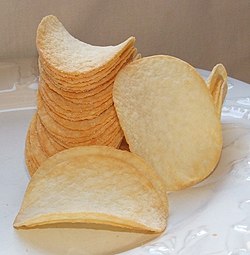Pringles
| Pringles Logo | |
| Product type | Potato Crisps |
|---|---|
| Owner | Procter & Gamble |
| Country | |
| Markets | Worldwide |
| Website | http://www.pringles.com/ |

Pringles are a brand of potato chips produced by Procter & Gamble. Pringles are sold in over 30 countries and have yearly sales of over one billion dollars. [1]
Pringles were first sold in the United States in October of 1968; they were not rolled out across America until the mid-1970s[2]. They were originally known as "Pringle's Newfangled Potato Chips", but the name was changed for introduction to the national market. Procter & Gamble chose the Pringles name from a Cincinnati telephone book, selecting Pringle Avenue in Finneytown, Ohio for its pleasing sound.[3] The original Pringles television commercials were written, produced and directed by Thomas Scott Cadden (composer of the original Mr. Clean Jingle) in 1968 while working at Tatham-Laird and Kudner Advertising Agency in Chicago.
Pringles are advertised in the United States with the slogan "Everything Pops with Pringles", and in the UK and elsewhere with "Once you pop, you can't stop."[4] In the United States, Pringles are no longer marketed as potato chips, but rather "potato crisps".
According to the patent, Pringles were invented by Alexander Liepa of Montgomery, Ohio.[5] Science Fiction and Fantasy author Gene Wolfe developed the machine that cooks them.[6] Pringles are especially known for their packaging, a tubular can with a foil-coated interior and a resealable plastic lid, that was invented by Fredric J. Baur. Mr. Baur was an organic chemist and food storage technician who specialized in research and development and quality control for Cincinnati-based Procter & Gamble Co. He passed away on May 4, 2008. Baur's children honored his request to bury him in one of the cans by placing part of his cremated remains in a Pringles container in his grave.[7]
The Pringles logo is a stylized representation of a man with a large moustache and parted bangs (until 2001, the man, still commonly known as "Julius Pringles", had eyebrows and his bow tie housed the product name.) The crisps are made to a uniform size and a hyperbolic paraboloid saddle shape, so that they stack very efficiently within the container, rather than being packaged loosely in a bag. The cans come in 230g, 170g, 163g, 160g, 155g, 50g, and 23g sizes. In early 2007, the company introduced an 80g size.[8]
Pringles come in several flavors, and occasionally Procter & Gamble produces limited edition runs. Some flavors may be distributed only to limited market areas. Seasonal flavors, past and present, include ketchup, chili cheese dog, and Cajun. At one point in the early 90's, "Corn Pringles" were available. The canister was black and had cartoon images of corn as well as the normal packaging standards. The crisps were made of corn and resembled a corn chip in flavor and texture.
In a London courtroom, July 2008, Procter & Gamble lawyers successfully argued that Pringles are not potato crisp, as their actual potato content is only 42%. This exempts Pringles from the 15% Value Added Tax for Potato crisps and potato-derived snacks. [9] The can does still however bear the words "Potato Crisps."
Pringles container uses
Because of the metallic interior and long, tubular shape, the cans have been used to make Wi-Fi network antennas, known as cantennas[10].
Cans can also be use to make "Cannons" or poppers, by putting a round hole in the bottom end of the can and blowing hard a loud popping sound will be made as the lid flies off. When filled with little bits of paper it shoots out confetti.
The popular newspaper comic Dilbert references a use for the Pringles can. Dilbert rolls up his clothing in a Pringles tube so he can change clothes at work without having to drive home and change clothes.
Pringles containers can also be used to hold up to three tennis balls. This similarity of shape was the subject of a joke by Mitch Hedberg, who speculated that tennis balls were what Pringles had originally intended to make.
References
- ^ "ACNielsen Study Finds 43 Brands Have Billion Dollar Global Presence". ACNielsen.
- ^ "Pringles". Procter & Gamble UK. 2007. Retrieved 2007-06-24.
- ^ "Pringles". Procter & Gamble Everyday Solutions Canada. 2007. Retrieved 2007-06-24.
- ^ "Pringles". Procter & Gamble. 2007. Retrieved 2007-10-14.
- ^ Pringles patent
- ^ Lawrence Person (Fall/Winter 1998). "Suns new, long, and short: an interview with Gene Wolfe". Nova Express. 5 (1). Retrieved 2007-06-24.
{{cite journal}}: Check date values in:|date=(help) - ^ "Ashes of Pringles can designer buried in his work". Associated Press. 2008-06-02. Retrieved 2008-06-02.
- ^ "80g Original Pringles". Barcodepedia. 2007. Retrieved 2007-06-24.
- ^ "Pringles 'are not potato crisps'". BBC. 2008. Retrieved 2008-07-04.
- ^ Pringles cantenna
